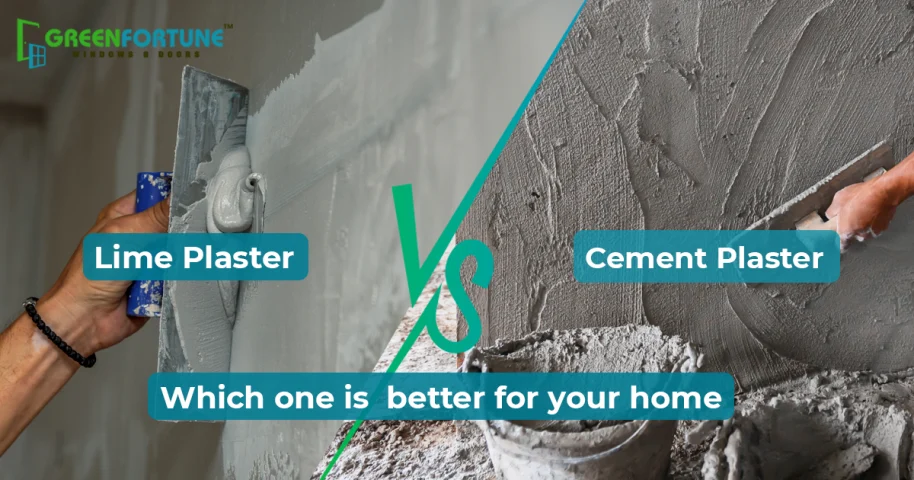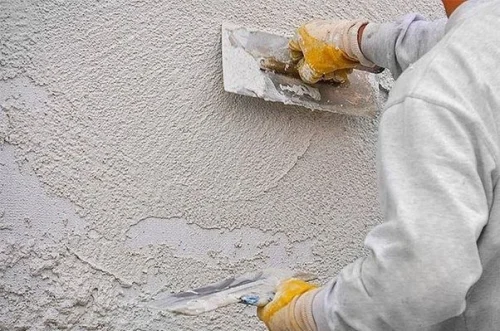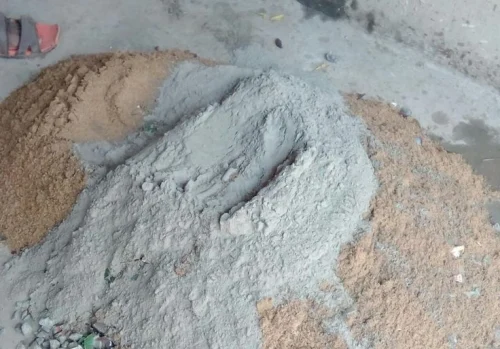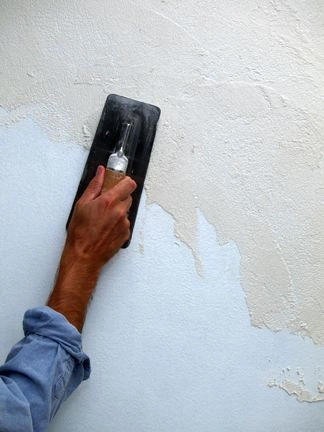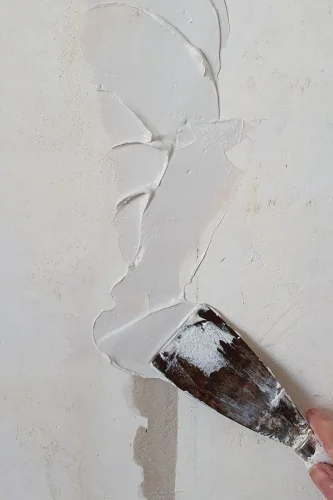
What’s the Colour Drenching Trend That’s Taking Over the World? Should You Try It Too?
July 24, 2025
Building Net Zero Energy Homes in India: Cost, Design & Benefits
July 24, 2025If you’re building or renovating your home, there’s something very important you shouldn’t overlook, ‘plaster’. Missing this step can lead to poor air quality indoors and dampness or cracks on your walls.
Plaster is the layer that covers your brick walls and creates a smooth base for paint, tiles or any finish. The right plaster keeps moisture away, helps your walls breathe and makes your paint last longer.
In this blog, we’ll break down lime plaster vs cement plaster, compare costs, benefits, pros and cons, and help you choose the best one for your home.
Also read: 7 stunning false ceiling ideas for your home!
Table of contents
- What Is Lime Plaster?
- What Are The Benefits Of Lime Plaster?
- What Are The Disadvantages Of Lime Plaster?
- What Is Cement Plaster?
- What Are The Benefits Of Cement Plaster?
- What Are The Disadvantages Of Cement Plaster?
- So, Here Are The Key Differences: Lime Plaster Vs Cement Plaster
- How To Choose Between Lime Plaster Vs Cement Plaster?
- Final thoughts
What Is Lime Plaster?
Lime plaster is a natural wall coating made by mixing slaked lime (calcium hydroxide), clean sand, and water.
In traditional Indian methods, organic materials like natural fibres like hemp or even a bit of cow dung are added, as they help bind the mix well and resist pests. It is one of the oldest ways to finish walls and ceilings.
Lime plaster is great for interior walls of living rooms, bedrooms, and heritage restorations. It is popular for homes in coastal belts or places with heavy monsoons.
What Are The Benefits Of Lime Plaster?
Here are the top benefits of lime plaster.
- Breathability: It lets moisture escape naturally. So walls stay dry, making it suitable for humid and coastal areas.
- Flexibility: Lime is slightly flexible, so it expands and shrinks with small movements in the building and weather changes. The chances for the hairline cracks to appear are very less.
- Durability: Lime-plastered walls stand the test of time and stay strong even after 50 to 100 years.
- Sustainability: It produces less CO₂ than cement plaster and absorbs CO₂ while setting. It is one of the best eco friendly plaster materials.
- Healthier indoors: Lime’s alkaline nature naturally resists mold and harmful bacteria. There is no need to use harsh chemicals, VOCs.
- Thermal comfort: Lime-plastered walls keep interiors cooler in summer and warmer in winter.
What Are The Disadvantages Of Lime Plaster?
Though lime plaster has many advantages, it comes with practical challenges.
- You will need experienced masons who know how to prepare and apply lime plaster.
- Lime plaster takes a longer time to set and cure than cement plaster. So, projects can take a bit longer.
- Lime plaster costs slightly more upfront. It is because materials and skilled labour for lime plaster usually cost a little more than cement.
In this lime plaster vs cement plaster guide, let’s move to cement plaster next.
Also read: How to repair a wall crack at home?
What Is Cement Plaster?
Cement plaster is made by mixing cement, sand and water with additional chemical additives for quicker setting and better sticking. In India, most of the builders opt for cement plaster because it is the fastest, cheapest option.
Cement plaster is great for mass housing, modern high-rise apartments, and large buildings.
What Are The Benefits Of Cement Plaster?
Here are the top benefits of cement plaster.
- Strength and durability: Cement plaster gives a hard, tough finish and is well-suitable for day-to-day wear and tear.
- Water resistance: If mixed and cured properly, cement plaster forms a dense layer that holds off rain and water penetration. However, damp-proofing behind it is still needed.
- Faster setting time: Cement plaster dries nd sets quickly. This saves construction time and is a huge plus if you are running on tight schedules.
- Cost-effective: Since the materials and labour are cheap and widely available, cement plastering is budget-friendly.
- Smooth finish: Cement plaster provides an even base for paint, tiles, POP ceilings, or any finishes.
- Easy to apply: Any mason will know how to apply cement plaster, as it doesn’t require any special skills.
What Are The Disadvantages Of Cement Plaster?
Here are the cement plaster disadvantages.
- Cement plaster is rigid, and so it is prone to cracks if your building settles or faces temperature swings.
- Unlike lime, cement plaster doesn’t let walls breathe. If moisture gets trapped inside, the paint can bubble, the walls stay wet, and mold may grow.
- Cement is one of the biggest sources of CO₂ emissions. Using it raises your building’s carbon footprint.
- There is a possibility that the presence of chemical additives in modern cement plasters affects air quality.
Also read: Why PVC false ceiling is the best choice?
So, Here Are The Key Differences: Lime Plaster Vs Cement Plaster
Here is a comparison of lime plaster vs cement plaster.
Aspect | Lime Plaster | Cement Plaster |
Material | Lime, sand, water, natural fibres | Cement, sand, water, chemical additives |
Breathability | High, lets moisture out | Low, traps dampness |
Flexibility | Slightly flexible, resists cracks | Rigid, cracks easily |
Indoor health | Chemical-free, naturally mold-resistant | Can trap dampness, contains chemical additives |
Eco impact | Low carbon footprint, absorbs CO₂ | High carbon footprint |
Time to apply | Take more time to apply, needs curing time | Quick to apply, dries fast |
Labour | Skilled mason needed | Any mason can do it |
Cost | Higher upfront cost, less repair over time. Requires more layers for good coverage | Cheaper upfront, may need more repairs later |
Cost range | Lime plaster: INR 100 to INR 300 per sq. ft. (labour+material) Price also depends on the location & type of lime plaster finishes, like Venetian, rustic texture or lime wash. | Cement plaster: INR 35 to INR 75 per sq. ft. (labour+sand+cement) |
How To Choose Between Lime Plaster Vs Cement Plaster?
Go for lime plaster if,
- You are building or restoring an old home, villa or heritage-style house.
- Your home is located near the coast, in a humid or damp zone.
- You want breathable walls that fight damp and mold and improve air quality.
- You prefer an earthy, natural matte look.
- You are okay with paying a bit more upfront to save on repairs later.
- You care about eco-friendly plaster materials that reduce your home’s carbon footprint.
- You could get experienced masons to apply lime plaster correctly.
Go for cement plaster if,
- Yours is a flat in a high-rise building.
- Your walls are in dry zones or will be fully tiled or waterproofed anyway.
- You want a smooth, hard surface that is ready for paint, POP, tiles or any finishes.
- You want the plaster to dry quickly to keep the construction moving without any delay.
Also read: Step-by-step guide for waterproofing terrace!
Final thoughts
While upgrading your home, do not forget to install GreenFortune’s uPVC windows and doors. They last long, are weather-resistant, thermally insulated, eco-friendly and reduce noise and look stylish.
So, in this lime plaster vs cement plaster comparison, if you are unsure which plaster to pick for your home, analyse based on your building type, moisture levels, desired finish, cost & labour, and sustainability aspects.
FAQs
1). Why is lime plaster no longer commonly used?
Lime plaster is no longer commonly used because fewer masons know the old methods to mix and apply it properly, so most builders just use faster, easier cement plaster instead. It requires more time to apply and dry, and costs more upfront.
2). What is the strongest type of plaster?
The strongest type of plaster is cement plaster. It is because it sets fast and hard. The second-good option is gypsum plaster. It can be used for indoors.
3). How long will lime and cement plaster last?
Lime plaster can last over 100 years if maintained, which is why old homes still have it. Cement plaster usually lasts for 15 to 20 years before it cracks or any repairs occur.







